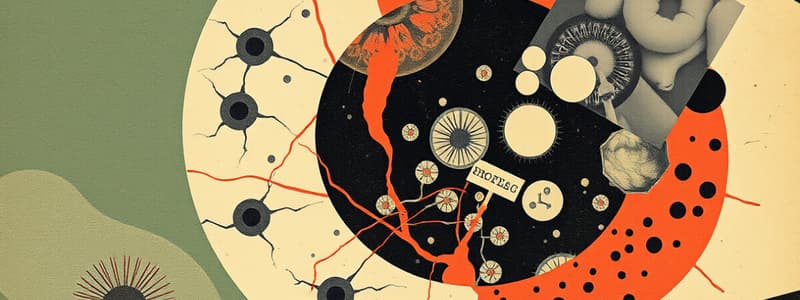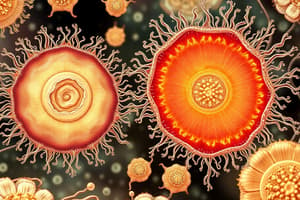Podcast
Questions and Answers
What is the function of the nucleus?
What is the function of the nucleus?
Stores genetic information and controls genetic functions in all eukaryotic cells.
What is the role of the endoplasmic reticulum?
What is the role of the endoplasmic reticulum?
Connects to the nuclear envelope, modifies proteins, and synthesizes lipids.
What do ribosomes do?
What do ribosomes do?
They are responsible for protein synthesis through the translation of RNA.
What is the function of the Golgi apparatus?
What is the function of the Golgi apparatus?
What do lysosomes contain?
What do lysosomes contain?
What energy conversion takes place in mitochondria?
What energy conversion takes place in mitochondria?
Where does photosynthesis take place?
Where does photosynthesis take place?
What is the primary function of the vacuole in plant cells?
What is the primary function of the vacuole in plant cells?
What does the cytoplasm contain?
What does the cytoplasm contain?
What is the cytoskeleton's role?
What is the cytoskeleton's role?
What is the plasma membrane made of?
What is the plasma membrane made of?
What is the function of the cell wall?
What is the function of the cell wall?
What do plasmodesmata do?
What do plasmodesmata do?
What is the purpose of the capsule in some bacteria?
What is the purpose of the capsule in some bacteria?
What is the function of flagella in bacteria?
What is the function of flagella in bacteria?
What do pili do?
What do pili do?
What pigments do chromoplasts contain?
What pigments do chromoplasts contain?
What do leucoplasts store?
What do leucoplasts store?
What do peroxisomes break down?
What do peroxisomes break down?
What do glyoxysomes convert?
What do glyoxysomes convert?
Flashcards are hidden until you start studying
Study Notes
Cell Components Overview
-
Nucleus:
- Found in all eukaryotic cells.
- Stores genetic information and is the site of cellular genetic control.
- Surrounded by a double membrane that contributes to the endoplasmic reticulum.
-
Endoplasmic Reticulum (ER):
- Present in all eukaryotic cells and connects to the nuclear envelope.
- Rough ER has ribosomes; involved in protein folding and carbohydrate addition.
- Smooth ER modifies proteins, handles small molecules, synthesizes steroids/lipids, and breaks down glycogen.
-
Ribosomes:
- Found in all cell types.
- Composed of RNA and protein; responsible for protein assembly through translation.
-
Golgi Apparatus:
- Present in animal and plant cells.
- Modifies, concentrates, and packages proteins for transport to various locations.
-
Lysosomes:
- Found in animal cells.
- Double membrane structure containing digestive enzymes that hydrolyze macromolecules.
-
Mitochondria:
- Present in both animal and plant cells.
- Double membrane organelle that converts glucose into ATP, requiring oxygen.
-
Chloroplasts:
- Found in plant cells, algae, and some archaea.
- Contains chlorophyll; site of photosynthesis, converting light energy, water, and CO2 into carbohydrates and oxygen.
Storage and Structural Components
-
Vacuole:
- Present in plant and protist cells.
- Large membrane-bound space that stores waste products and provides structural support when full.
- Responsible for pigmentation in petals and fruits, as well as protein digestion in seeds.
-
Cytoplasm:
- Present in most cell types.
- Aqueous solution filling the cell, containing dissolved ions and molecules.
-
Cytoskeleton:
- Found in some prokaryotic and all eukaryotic cells.
- Internal network providing structure, enabling movement, and positioning organelles.
-
Plasma Membrane:
- Composed of a phospholipid bilayer with proteins.
- Maintains internal cell environment and regulates molecule passage.
- Facilitates communication and adhesion between cells.
Protective and Communication Structures
-
Cell Wall:
- Found in plant, bacterial, and fungal cells.
- Located outside the plasma membrane, maintaining shape and limiting cell size.
- Protects against pathogens; composed of cellulose in plants and peptidoglycan in bacteria.
-
Plasmodesma:
- Present in plant, bacterial, and fungal cells.
- Channels in cell walls connecting plasma membranes of adjacent cells for communication.
-
Capsule:
- Found in some prokaryotic (bacterial) cells.
- Composed of polysaccharides; provides protection against dehydration.
-
Flagellum:
- Present in bacterial cells.
- Propulsion mechanism for unicellular or small multicellular organisms.
-
Pili:
- Found on bacterial surfaces as hairlike appendages.
- Used for adherence to other cells for nutrient acquisition or bacterial mating.
Specialized Organelles
-
Chromoplasts:
- Present in plants and some protist cells.
- Contain pigments like red, orange, and yellow, contributing color to plant structures.
-
Leucoplasts:
- Found in plants and some protists.
- Function primarily in the storage of fats and starch.
-
Peroxisomes:
- Present in eukaryotic cells.
- Collect toxic peroxide by-products and break them down into water and oxygen.
-
Glyoxysomes:
- Found in plant cells.
- Convert stored lipids into carbohydrates for use in growing cells.
Studying That Suits You
Use AI to generate personalized quizzes and flashcards to suit your learning preferences.




